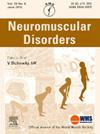免疫介导坏死性肌病(IMNM)新出现的非典型临床病理表现
IF 2.7
4区 医学
Q2 CLINICAL NEUROLOGY
引用次数: 0
摘要
免疫介导的坏死性肌病(IMNM)是一种自身免疫性肌病,其典型特征是亚急性发病,快速进展的近端显性无力,肌酸激酶(CK)水平显著升高,肌肉病理特征是坏死和再生纤维,淋巴细胞浸润很少或没有。IMNM可与抗hmgcr和抗srp抗体相关。加快诊断和开始免疫治疗很重要,因为早期治疗可以改善患者的症状和结果。值得注意的是,最近的证据揭示了IMNM的几种非典型临床和组织病理学表型,这使得识别这种可治疗的疾病具有挑战性。有报道称,血清阳性的IMNM患者表现为慢性缓慢进行性虚弱,类似于肢带肌营养不良,以及孤立的吞咽困难,突出的眼球受累,或面肩肱骨肌营养不良样表型。一些患者可能在症状前阶段出现无症状高血血症。IMNM的肌病理发现也扩大到包括小管聚集、肌纤维病理、线粒体肌病、过度脂质积累和巨突病理等特征。本综述的目的是强调IMNM的这些不寻常的临床和组织病理学表现,因为认识到IMNM的这些非典型特征对于加速诊断、启动适当的免疫治疗和改善这种可治疗的肌病的预后至关重要。本文章由计算机程序翻译,如有差异,请以英文原文为准。
Emerging atypical clinicopathological manifestations of immune-mediated necrotizing myopathy (IMNM)
Immune-mediated necrotizing myopathy (IMNM) is an autoimmune myopathy typically characterized by a subacute-onset, rapidly progressive proximal predominant weakness, markedly elevated creatine kinase (CK) levels, and myopathological features of necrotic and regenerating fibers with minimal or no lymphocytic infiltration. IMNM can be associated with anti-HMGCR and anti-SRP antibodies. Expediting a diagnosis and beginning treatment with immunotherapy is important as early treatment can improve patient symptoms and outcomes. Notably, recent evidence has revealed several atypical clinical and histopathologic phenotypes of IMNM, which can make recognizing this treatable disease challenging. There are reports of seropositive IMNM patients exhibiting a chronic and slowly progressive course of weakness, resembling limb-girdle muscular dystrophy, as well as isolated dysphagia, prominent oculobulbar involvement, or facioscapulohumeral muscular dystrophy-like phenotype. Some patients may present in presymptomatic stages with asymptomatic hyperCKemia. Myopathological findings of IMNM have also expanded to encompass features including tubular aggregates, myofibrillar pathology, mitochondrial myopathy, excessive lipid cumulation, and megaconial pathology. The aim of this review is to highlight these unusual clinical and histopathologic presentations of IMNM, as recognizing these atypical features of IMNM is crucial to expedite diagnosis, initiate appropriate immunotherapies, and improving prognosis in this treatable myopathy.
求助全文
通过发布文献求助,成功后即可免费获取论文全文。
去求助
来源期刊

Neuromuscular Disorders
医学-临床神经学
CiteScore
4.60
自引率
3.60%
发文量
543
审稿时长
53 days
期刊介绍:
This international, multidisciplinary journal covers all aspects of neuromuscular disorders in childhood and adult life (including the muscular dystrophies, spinal muscular atrophies, hereditary neuropathies, congenital myopathies, myasthenias, myotonic syndromes, metabolic myopathies and inflammatory myopathies).
The Editors welcome original articles from all areas of the field:
• Clinical aspects, such as new clinical entities, case studies of interest, treatment, management and rehabilitation (including biomechanics, orthotic design and surgery).
• Basic scientific studies of relevance to the clinical syndromes, including advances in the fields of molecular biology and genetics.
• Studies of animal models relevant to the human diseases.
The journal is aimed at a wide range of clinicians, pathologists, associated paramedical professionals and clinical and basic scientists with an interest in the study of neuromuscular disorders.
 求助内容:
求助内容: 应助结果提醒方式:
应助结果提醒方式:


